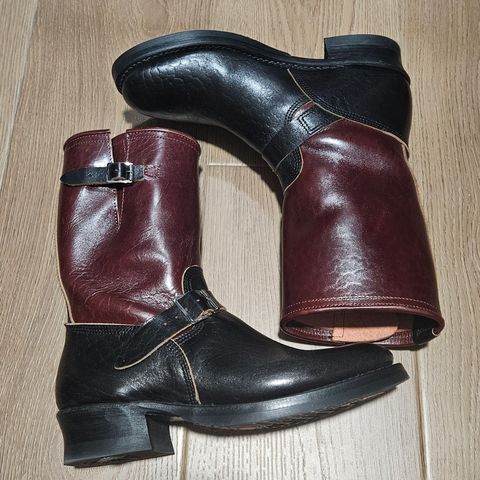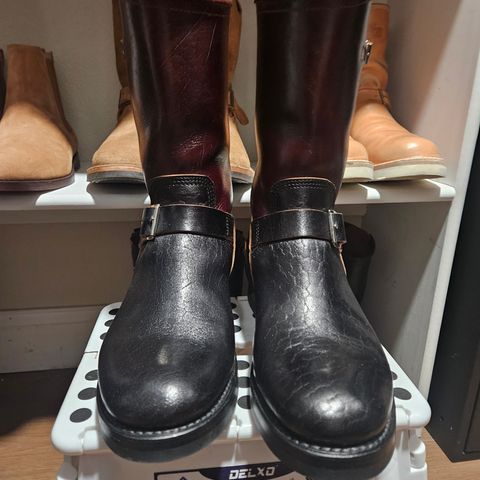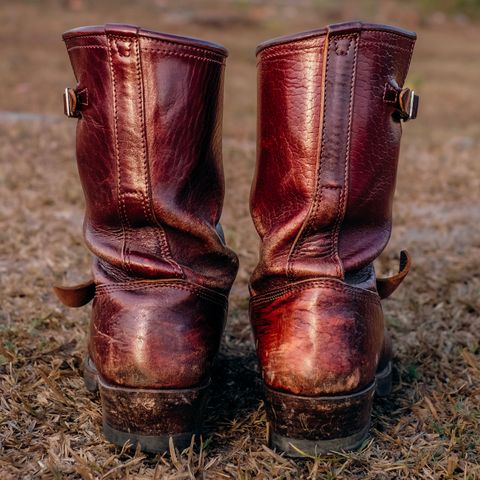About
Shinki Burgundy Oiled Horsebutt is a vegetable-tanned horsehide leather produced by Shinki Hikaku tannery in Himeji, Japan. The leather features a rich, deep red-brown burgundy finish applied over vegetable-tanned horsebutt, combining the dense fibrous structure characteristic of equine rump leather with oil, wax, and resin treatments that enhance durability and patina development.
About
Shinki Burgundy Oiled Horsebutt is a vegetable-tanned horsehide leather produced by Shinki Hikaku tannery in Himeji, Japan. The leather features a rich, deep red-brown burgundy finish applied over vegetable-tanned horsebutt, combining the dense fibrous structure characteristic of equine rump leather with oil, wax, and resin treatments that enhance durability and patina development.
As part of Shinki's Oiled Horsebutt collection, the burgundy color variant represents the tannery's approach to creating deeply saturated colors through traditional vegetable tanning combined with modern finishing techniques. The full aniline finish preserves the leather's natural grain characteristics while the oiled treatment creates a soft, supple texture from the outset.
Characteristics
Physical Properties
Shinki Burgundy Oiled Horsebutt exhibits the dense fibrous structure characteristic of horsehide from the rump area. The leather measures approximately 3 ounces (1.2mm) in thickness, though it can be split to various thickness ranges depending on application requirements. The material demonstrates high tensile strength while maintaining flexibility, allowing it to shape and mold during use.
The dense grain structure provides exceptional durability and resistance to wear. Unlike cowhide, which has larger and more irregular grain patterns, horsebutt features a tight, uniform grain that contributes to the leather's strength and distinctive aging characteristics. The grain remains visible through the aniline finish, showing natural marks including veins, scratches, and blemishes acquired during the animal's life.
The oil content exceeds 15 percent of the leather's weight, creating a soft, slightly worn-in feel from initial use. This oil saturation reinforces the leather's fibers, making them resistant to cracking, splitting, or hardening even under stress. The oiled treatment produces a characteristic pull-up effect where lighter lines and color variations appear when the leather is flexed or stretched as oils and waxes shift within the structure.
Color and Finish
The burgundy coloration presents as a rich, deep red-brown that ranks among the most saturated colors produced by any tannery. Shinki Hikaku applies the burgundy dye to vegetable-tanned horsebutt, creating complete color penetration through the leather's thickness. The glossy aniline finish creates a polished luster with minimal waxy feel compared to horsehide from other tanneries.
The full aniline finish means no surface coating obscures the leather's natural characteristics. All natural marks, grain variations, and surface features remain visible, contributing to each hide's unique appearance. The burgundy color deepens in areas of wear and handling, creating visual complexity as the leather ages.
Production Process
Vegetable Tanning
Shinki Hikaku employs traditional pit tanning methods using mimosa bark tannins imported from Australia. The tanning process takes approximately four months from raw hide to finished leather. Raw horsehides sourced from European suppliers undergo extensive washing and cleaning before entering tanning pits where they soak in tanning liquor with continuous agitation.
The vegetable tanning process creates the foundation for the burgundy color application. Mimosa tannins produce a pinkish-brown base that contributes to the leather's eventual patina development. The lengthy tanning period allows tannins to penetrate completely through the hide, creating leather that is tanned consistently from surface to core.
Source Material
The horsebutt leather originates from the loin and rump areas of horsehide, regions characterized by dense fiber structure and durability. Shinki Hikaku, founded in 1951, specializes exclusively in horse leather production, making it the only tannery globally to focus solely on equine hides. This specialization contributes to the tannery's expertise in selecting and processing horsebutt leather.
European horse hides arrive from well-regulated regions with high animal welfare standards. The hides come from horses processed for the food industry, representing a secondary use of material that would otherwise be discarded. The tannery processes approximately 30 percent less volume during production as hides shrink through the tanning and finishing stages.
Oiled Treatment
Following vegetable tanning and burgundy dye application, the leather receives oil, wax, and resin treatments. This combination creates the characteristic oiled horsebutt properties including enhanced water resistance, stain resistance, and perspiration resistance. The treatment penetrates deeply into the leather structure rather than remaining as a surface coating.
The oiling process makes the leather essentially self-conditioning. Oils and waxes migrate from the leather's core to the surface over time, maintaining suppleness without regular application of conditioning products. The deep oil saturation contributes to the leather's softness while preserving structural integrity.
Aging and Patina Development
Color Evolution
Burgundy oiled horsebutt develops patina through environmental exposure and mechanical wear. The aniline finish creates a glossy coat that gradually wears away to reveal natural texture beneath. Areas of frequent handling darken first as skin oils transfer to the leather surface. Contact points and flex areas develop deeper, richer tones compared to protected sections.
The vegetable tanning foundation allows the burgundy color to evolve rather than fade uniformly. Lighter burgundy tones may emerge in areas of high stress as the surface finish wears, creating contrast with unworn sections. The full aniline finish ensures patina development remains visible rather than hidden beneath surface coatings.
Grain Development
The dense grain structure of horsebutt creates distinctive aging patterns. Rather than creasing sharply like some leathers, oiled horsebutt tends to roll and develop a honeycomb pattern of wrinkles. These wrinkles become more pronounced with use, creating three-dimensional texture across the leather's surface.
The tight grain ages quickly in ways appreciated by leather enthusiasts. Visible changes begin within months of regular use, with significant character development apparent after one year. The uniform grain structure means aging patterns develop consistently across the hide rather than showing weak points or irregular wear.
Oil Migration
As the leather ages, oils and waxes continue to migrate within the structure. Surface oils may create temporary blooming where wax rises to form a whitish layer. This natural phenomenon indicates active aging and can be removed through brushing or buffing. The oil migration helps maintain the leather's flexibility and water resistance throughout its lifespan.
Applications
Footwear
High-end bootmakers value Shinki Burgundy Oiled Horsebutt for heritage-style work boots and engineer boots. The leather's thickness, durability, and distinctive color make it appropriate for boots intended for both function and aesthetic appeal. The oiled treatment provides water resistance suitable for outdoor use while the burgundy color offers an alternative to standard brown and black options.
The dense horsebutt structure maintains boot shape while conforming to the wearer's foot over time. The leather's resistance to cracking and splitting makes it suitable for boots subjected to regular flexing and stress. The rolling crease pattern characteristic of horsebutt creates attractive wear patterns around toe boxes and ankle areas.
Leather Goods
Small leather goods including wallets, watch straps, and accessories benefit from burgundy oiled horsebutt's combination of durability and character. The leather's thickness can be split to accommodate products requiring thinner material while maintaining the dense grain structure. The burgundy color provides visual interest for items where patina development enhances appeal.
The oil saturation makes the leather appropriate for items experiencing frequent handling. Wallet interiors and exteriors maintain suppleness through regular use without requiring conditioning treatments. Watch straps develop personalized patina reflecting wear patterns unique to each user.
Care and Maintenance
Regular Maintenance
Burgundy oiled horsebutt requires minimal active maintenance due to its self-conditioning properties from the oiling process. Regular brushing with natural bristle brushes removes surface dirt and distributes oils evenly across the leather. For heavier soiling, wiping with a damp cloth removes debris without specialized cleaning products.
The glossy aniline finish can be preserved through routine buffing, though many users prefer allowing the finish to wear naturally for enhanced patina development. Moisturizing products formulated for aniline-finished leather can extend the glossy appearance, though the leather's oil content typically provides sufficient conditioning for extended periods.
Protection
While the oiled treatment provides water resistance, the leather should not be considered waterproof. Protection from prolonged moisture exposure prevents water staining and maintains the leather's structure. Heat sources should remain distant from burgundy oiled horsebutt as excessive heat draws out conditioning oils and potentially damages fiber structure.
The burgundy color demonstrates good colorfastness through normal use, though extended sun exposure may cause gradual fading over years. Storage in cool, dry conditions when not in use helps preserve color saturation and prevents premature aging.
Comparison to Other Leathers
Versus Other Shinki Colors
Burgundy oiled horsebutt shares production methods and base characteristics with other colors in Shinki's oiled horsebutt line. The primary distinction lies in dye application and resulting color evolution. Burgundy develops darker, richer patina compared to lighter colors like natural or cognac, which show more dramatic color transitions through aging.
The burgundy finish maintains its red-brown character throughout the leather's lifespan, though individual tones deepen and develop complexity. This contrasts with teacore colors that intentionally reveal contrasting undertones through wear.
Versus Cowhide
Compared to vegetable-tanned cowhide, burgundy oiled horsebutt demonstrates tighter grain structure, higher tensile strength, and more uniform aging patterns. The horsehide's dense fibers create a firmer feel with slight suppleness, while cowhide typically feels softer initially. Horsebutt ages more quickly and develops visible patina faster than most cowhide leathers.
The grain pattern differences create distinct visual characteristics. Horsebutt's uniform, tight grain produces consistent texture across the hide, while cowhide shows more variation in grain size and structure. These differences affect how each leather type accepts dyes and develops patina.
Historical Context
Shinki Hikaku was founded in 1951 in Himeji, Hyogo Prefecture, an area with over 1,500 years of leather-making history. The tannery's location on the banks of the Ichikawa River connects it to centuries of Japanese leather craftsmanship. The family-run operation has maintained focus on horse leather production for over 60 years, developing expertise in processing equine hides.
The tannery's commitment to traditional vegetable tanning methods combined with modern quality control has made its horsehide products sought after by premium bootmakers and leather goods manufacturers globally. The burgundy color represents one option within Shinki's broader palette of deeply saturated colors achieved through vegetable tanning and careful dye application.
References
"Shinki Hikaku Leather". John Lofgren Bootmaker. Retrieved October 11, 2025.
"Shinki Hikaku - Shell Cordovan - Veg Tanned (Burgundy)". RM Leather Supply. Retrieved October 11, 2025.
"Shinki Hikaku Tannery". VIBERG Journal. Retrieved October 11, 2025.
"Service Boot Shinki Horsebutt". VIBERG Journal. Retrieved October 11, 2025.
"Leather Information". Guarded Goods. Retrieved October 11, 2025.



































































